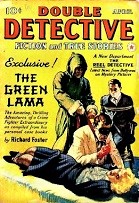
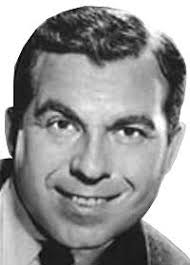 The Green Lama (June 5, 1949–August 20, 1949) aired “The Adventure of the Perfect Prisoner” on August 20, 1949 as the last of its 11 episodes, only 4 of which now remain in circulation. We have featured the other 3 existing episodes over the past few years, the last in February of 2020. Since this episode concludes the series and finalizes our airing of the existing episodes, the introduction prefacing the other episodes is repeated below.
The Green Lama (June 5, 1949–August 20, 1949) aired “The Adventure of the Perfect Prisoner” on August 20, 1949 as the last of its 11 episodes, only 4 of which now remain in circulation. We have featured the other 3 existing episodes over the past few years, the last in February of 2020. Since this episode concludes the series and finalizes our airing of the existing episodes, the introduction prefacing the other episodes is repeated below.
The character of the Green Lama has a colorful history that predates his brief radio show, so a few highlights are in order. The Green Lama was the brainchild of creator Kendell Foster Crossen who would write the Lama’s stories using the pen name of Richard Foster. Due to the popularity of The Shadow, other publishers sought to cash in by creating their own Shadow-like characters, the Avenger and the Green Lama being prime examples.
The Green Lama first appeared in a short novel-length story in the April 1940 issue of Double Detective (1937-1943, cover at left), and would be the cover story for the next 12 consecutive issues (ending with the October 1941 issue). Much like the Shadow, the Green Lama had his origins in the Far East, notably Tibet (and like the Green Hornet, the Green Lama has a sidekick/confidant from the Far East, played by dialectician Ben Wright, the master of many radio voices). His primary alter ego is Jethro Dumont, though others he would be known by were Dr. Charlies Pali and Hugh Gilmore. (Note that the Shadow went by several names as well.) Born of rich parents who were killed in an accident while attending Harvard (similar to the origin story of Bruce Wayne/Batman), Dumont would spend years in Tibet studying to be a lama (a spiritual teacher). While there he would acquire mystical powers of the supernatural variety that he would use to combat crime upon his return to the United States. Though the character’s superpowers would change from time to time from his magazine, comic book, and radio iterations, they included variously the ability to fly, travel through time, super speed and strength, the ability to throw energy beams, control fire, resurrect the dead, and control animals. Whew, talk about superpowers! To “activate” his powers (as in the episode here), the Green Lama would simply recite “Om mani padme hum” (which translated from the Sanskrit meant Om, the jewel on the lotus) and he was ready to rock and roll.
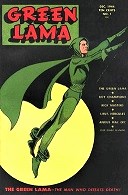 The Green Lama’s first Golden Age comic book appearance (as opposed to all of the newer comics over the years and unto the present) was in the December 1940 #7 issue of Prize Comics, and his name would appear in the comic book for the next 27 issues through 1943 (cover at left is from Green Lama #1, Dec. 1944). As noted, there have been numerous reprints and comics featuring the Green Lama, and they continue to the present day in small presses devoted to the pulps like Moonstone Publishers and Altus Press, to name just two.
The Green Lama’s first Golden Age comic book appearance (as opposed to all of the newer comics over the years and unto the present) was in the December 1940 #7 issue of Prize Comics, and his name would appear in the comic book for the next 27 issues through 1943 (cover at left is from Green Lama #1, Dec. 1944). As noted, there have been numerous reprints and comics featuring the Green Lama, and they continue to the present day in small presses devoted to the pulps like Moonstone Publishers and Altus Press, to name just two.
The Green Lama’s short-lived radio show hit the airwaves a few years after his pulp and comic book appearances were history. The Lama’s character would be played in all eleven episodes by ubiquitous radio and film actor Paul Frees (1920-1986, photo top right). Frees had several genre tie-ins including (but not limited to) 1951’s classic SF film The Thing (from Another World), as Dr. Voorhees, The War of the Worlds (1953, as a reporter), Earth vs. the Flying Saucers (1956, as one of the aliens’ voices, uncredited), King Kong Escapes (1967, as Dr. Hu), Beneath the Planet of the Apes (1970, as the ending Voiceover), The Last Unicorn (1982, as Mabruk), The Fantasy Film Worlds of George Pal (1985, as narrator of the documentary about the famed director), and finally, released in 1987, seven months after his death was The Puppetoon Movie where he was Arnie the Dinosaur/Pillsbury Doughboy (voice). The film was dedicated to Frees. For television Frees played a number of iconic roles, perhaps the most fondly remembered and recognizable was that of Boris Badenov in The Rocky and Bullwinkle Show (1959-64). He would also play the parts of other characters in the show and could be heard in 326 segments of 163 episodes. His final voice appearance came in 1984 in the episode of the television show Knight Rider. He was the voice of K.A.R.R. in the episode titled K.I.T.T. vs. K.A.R.R. If Mel Blanc was the man with a thousand voices, then Paul Frees wasn’t far behind.
Paul Frees died by suicide on November 2, 1986 from a self-administered overdose of pain medication.
“The Adventure of the Perfect Prisoner” takes place, as one might suspect, in a prison. It deals directly with the issue of whether the role of incarceration is one of punishment or rehabilitation. Jethro Dumont, the Green Lama, has a history of helping prisoners become once again useful members of society by mentoring select inmates from a prison the warden has turned into a model example of a penal institution. On a visit to meet the warden, now a friend, for a tour of the facilities, an exemplary prisoner set for early release is found murdered and the plot wheels are set in motion. Who killed this prisoner whose release was imminent, and why? And before a full scale investigation can be mounted there is a prisoner uprising—an armed uprising no less—with the prison’s hidden, secure armory now in the hands of the inmates. The keys to the armory and its store of rifles was known only to certain prison personnel, so who has now apparently aided in fomenting the forthcoming riot, and why has this individual turned on the warden of this so-called “model prison”? The answer to these questions, and others, pales before the plan to squelch the riot when the Green Lama decides to take his life in his hands by walking into the middle of the angry prisoners to talk to them, prisoners who have threatened to kill him on sight. It is a tense scenario, with a few twists and turns to keep the audience off balance, as the Green Lama gambles his very life on his ability to get to the truth behind the about face the prisoners have taken in “The Adventure of the Perfect Prisoner.”
Play Time: 29:53
{This final episode of The Green Lama aired on a Saturday night, meaning that after church the next morning the neighborhood gang would find themselves at the nearby newsstand in search of more thrilling fare, the sort they enjoyed on the radio the night before. They were in luck. Black Book Detective (1933-53), according to my primary reliable source, was a relatively “average” detective pulp until it introduced the character of the Black Bat in its July 1939 issue. The character [different from the Black Bat character with its own magazine (1933-34) and which was created by SF author Murray Leinster], featured in over half of the stories in the magazine from that point on, and is credited for the magazine surviving into the 1950s, well after most detective pulps had folded. Black Book Detective was transitioning from a bi-monthly to a quarterly in 1949 and saw 5 issues, 3 bi-monthly and 2 quarterly. Dime Detective Magazine (1931-53) was the longest running of Popular Publications’ detective magazine’s stable, with a final cover date of August 1953 and a final issue number of 274. Dime Detective was a monthly in 1949. Fantastic Novels’ (1940-41, 1948-51) attraction was its reprinting of early, classic science fiction and fantasy novels, many by well respected practitioners with loyal followings. The thirst for classic material for newer generations of readers proved successful as many of its stories have been repackaged dozens of times over the years, the A. Merritt novel teased on the cover of the issue below being but one of many of Merritt’s wonderful fantasies. Fantastic Novels was a bi-monthly in 1949.}
[Left: Black Book Detective, Summer/49 – Center: Dime Detective, 8/49 – Right: Fantastic Novels, 9/49]
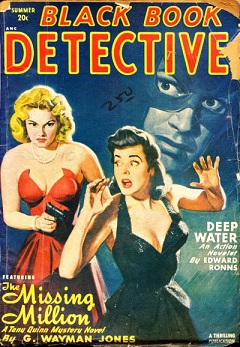
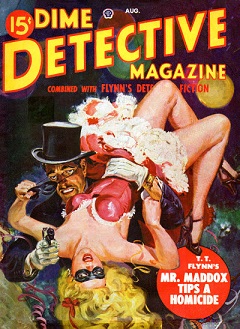
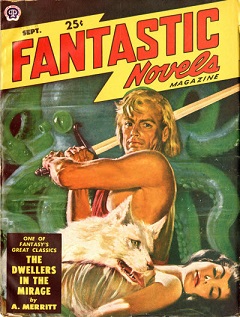
To view the entire list of weekly Old Time Radio episodes at Tangent Online, click here.